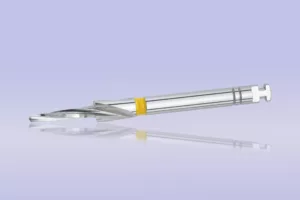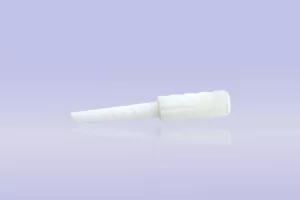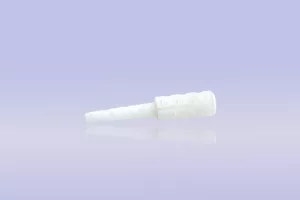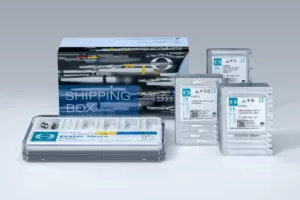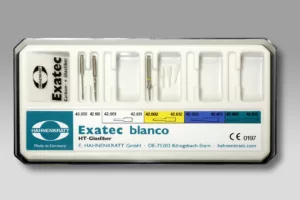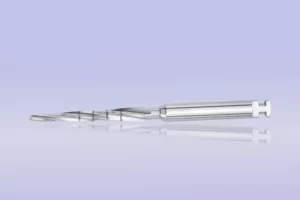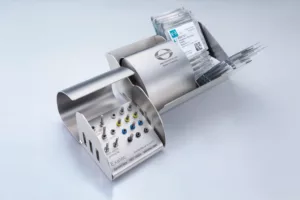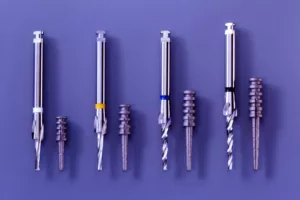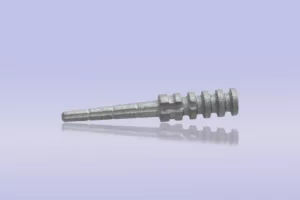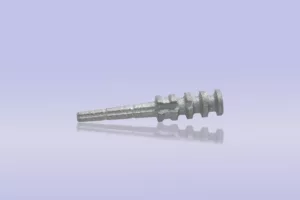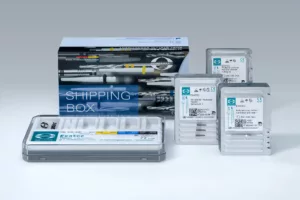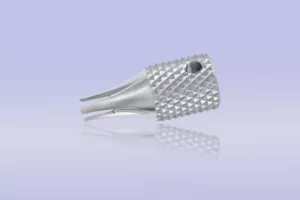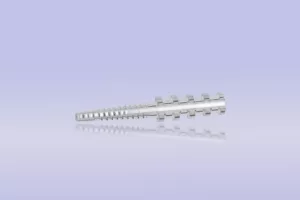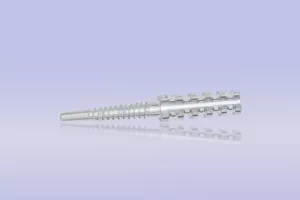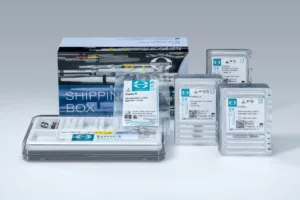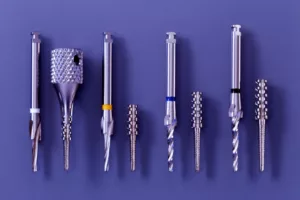Exatec
Exatec is suitable for teeth that are severely destroyed coronally. In the apical region, spiral-shaped retention lines optimize bonding (adhesion) with the composite and lead to protection against twisting. In the case of Exatec posts with posthead, the two longitudinal discharge grooves are used for decompression, or to allow excess composite to flow off.
Today, it is undisputed that root posts made of glass fiber offer advantages for a permanently stable root structure, such as a dentin-like elastic modulus to minimize the risk of root fractures. In addition, root canal revision – if the worst comes to the worst – is easy compared to titanium posts.
However, in 1995, when E. HAHNENKRATT GmbH was the first company in Germany to offer trend-setting carbon fiber root posts, all established manufacturers continued to rely on titanium root posts. There was great interest from universities in 1995 after the introduction of Composipost, but for many it took decades to revise entrenched conventional views. In 1998, a dissertation at the Charité Medical Faculty of the Humboldt University in Berlin still concluded that the application of a post made of fiber-reinforced composite in combination with the use of dual-curing composites was many times more expensive than insertion of a titanium post with the aid of zinc phosphate cement.*) Today, the use of composites and glass fiber root posts is standard practice.
*) The literature can be requested from the company E. HAHNENKRATT GmbH.
Exatec blanco
The advantages of Exatec blanco are:
High bending strength &
HT glass fiber 1.678 MPa (according to EN ISO 178) optimizes the stability of the root structure.
Homogeneity of the root construction
Due to the dentine-like modulus of elasticity of 13.6 GPa (according to DIN 53390), the transfer of
stresses on the dentin – and thus the risk of root fracture – is minimized.
Secure adhesion due to micro-retentive surface
Due to the fiber-structured, microretentive surface, no silanizing is necessary, proven by scientific tests.
Scientifically tested and proven in practice since 1995
In 1995, HAHNENKRATT was the first company in Germany to produce root posts from fiber-reinforced composite materials.
Today, it is undisputed that root posts made of glass fiber offer advantages for a permanently stable root structure, such as a dentin-like elastic modulus to minimize the risk of root fractures. In addition, root canal revision – if the worst comes to the worst – is easy compared to titanium posts.
However, in 1995, when E. HAHNENKRATT GmbH was the first company in Germany to offer trend-setting carbon fiber root posts, all established manufacturers continued to rely on titanium root posts. There was great interest from universities in 1995 after the introduction of Composipost, but for many it took decades to revise entrenched conventional views. In 1998, a dissertation at the Charité Medical Faculty of the Humboldt University in Berlin still concluded that the application of a post made of fiber-reinforced composite in combination with the use of dual-curing composites was many times more expensive than insertion of a titanium post with the aid of zinc phosphate cement.*) Today, the use of composites and glass fiber root posts is standard practice.
*) The literature can be requested from the company E. HAHNENKRATT GmbH.
Results from scientific work as well as practice-oriented long-term experience for more than 25 years – such as at the ZZMK Carolinum in Frankfurt – show superior advantages of our post systems, such as the micro-retentive post surface.
Studies at three different German universities showed that the unique surface structure leads to optimized bonding between the post and the adhesive luting material – without the use of a silane or primer.
The Standard Sets and Test Sets are shipped in a SHIPPING BOX.
Posts and Drills each in blister packs.
-
Calibration drill Exatec
7,17 €plus shipping costs
Product contains: 1 Piece per PU
-
plus shipping costs
Product contains: 10 Piece per PU
-
plus shipping costs
Product contains: 5 Piece per PU
-
plus shipping costs
Product contains: 1 Piece per PU
-
plus shipping costs
Product contains: 1 Piece per PU
-
Pilot drill, universal
7,17 €plus shipping costs
Product contains: 1 Piece per PU
-
plus shipping costs
Product contains: 1 Piece per PU
Exatec Titanium
The Standard Sets and Test Sets are shipped in a SHIPPING BOX.
Posts and Drills each in blister packs.
-
Calibration drill Exatec
7,17 €plus shipping costs
Product contains: 1 Piece per PU
-
Exatec Titan Test Set Size 2
24,98 €plus shipping costs
Product contains: 1 Piece per PU
-
plus shipping costs
-
plus shipping costs
-
Exatec Titanium Standard Set
127,20 €plus shipping costs
Product contains: 1 Piece per PU
Exatec-S Titanium
The Standard Sets and Test Sets are shipped in a SHIPPING BOX.
Posts and Drills each in blister packs.
-
Exatec-S Insertion Tool
17,82 €plus shipping costs
Product contains: 1 Piece per PU
-
plus shipping costs
-
plus shipping costs
-
Exatec-S Titanium Standard Set
147,75 €plus shipping costs
Product contains: 1 Piece per PU
-
plus shipping costs
Product contains: 1 Piece per PU

